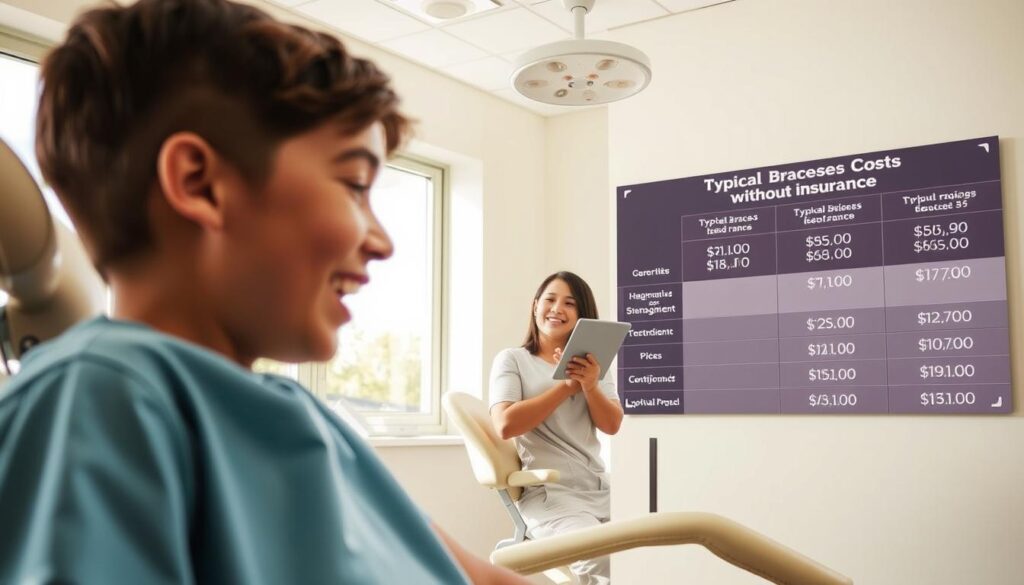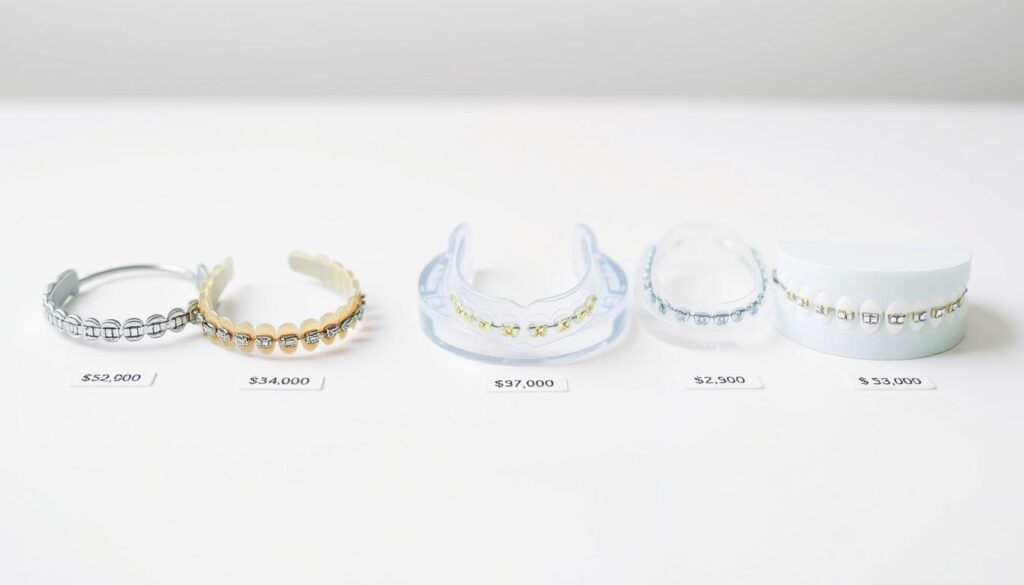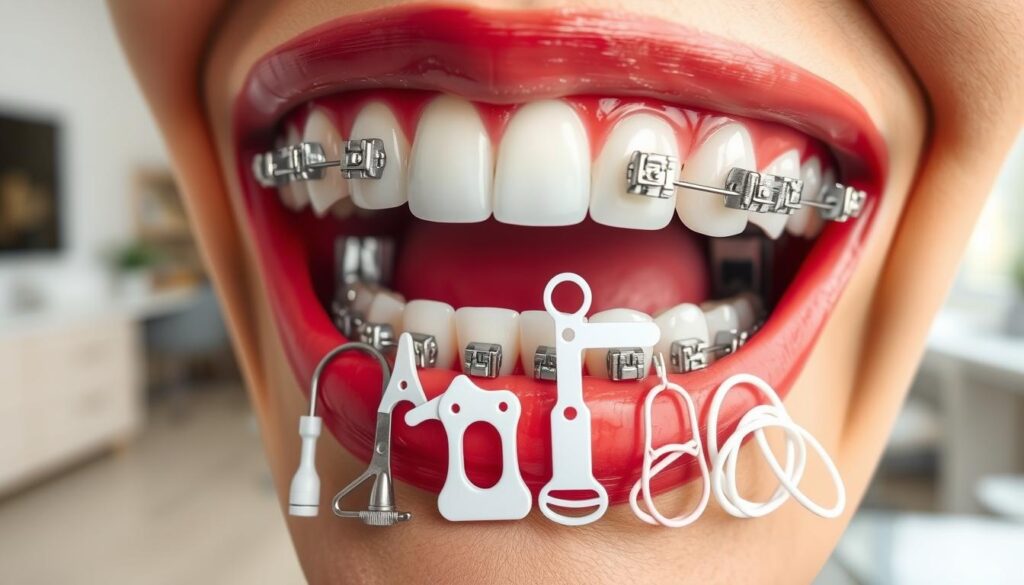Thinking about getting braces but worried about the cost? You’re not alone. Many people and families struggle to pay for braces without insurance. Knowing what to expect can help a lot.
Getting braces is a big step for your teeth and health. The price of braces without insurance can change a lot. This depends on the type of braces and how complex your case is.
Key Takeaways
- The cost of braces varies significantly based on the type of orthodontic treatment.
- Several factors influence the total expense, including location and the orthodontist’s fees.
- Understanding your payment options is crucial for managing costs.
- Some orthodontists offer financing plans or discounts for certain treatments.
- It’s essential to consult with an orthodontist to get a precise estimate for your treatment.
Understanding the Basics of Orthodontic Treatment Costs
When you think about orthodontic treatment, knowing the costs is key. It’s a big investment, and understanding what you’re paying for is important. This helps you make smart choices about your treatment.
What You’re Actually Paying For
Orthodontic treatment costs more than just braces. You’re also paying for the orthodontist’s expertise, the materials, and time for adjustments. Initial consultations, X-rays, and diagnostic tools add to the cost. Plus, there are follow-up visits and any repairs needed.
Why Insurance Often Doesn’t Cover Braces
Many insurance plans don’t cover orthodontic treatment, or they only cover part of it. This is because orthodontic care is seen as cosmetic, not medically necessary. But, some treatments might be covered if they’re medically needed.
The Difference Between Cosmetic and Medically Necessary Treatment
It’s important to know the difference between cosmetic and medically necessary treatments. Cosmetic treatments improve your teeth’s look. Medically necessary treatments fix health issues, like chewing or speaking problems.
How Much Is It For Braces Without Insurance: National Average Costs
Knowing the average cost of braces without insurance is key for planning your treatment. Costs vary based on several factors. These include the type of braces, the complexity of the issues, and the location.
Traditional Metal Braces Cost Breakdown
Traditional metal braces are often the cheapest option. They can cost between $3,000 and $7,000. This price includes the braces, adjustments, and follow-up care.

Regional Price Variations Across the US
Braces costs differ across the US. Urban areas like New York or Los Angeles charge more. This is because of the higher cost of living and business costs.
Urban vs. Rural Price Differences
Prices vary between urban and rural areas. Urban areas have higher costs due to living expenses and business costs. Rural areas might be cheaper but may require more travel.
When looking at how much braces will cost without insurance, compare prices in your area. Talking to several orthodontists can help you understand the average costs better.
Different Types of Braces and Their Price Points
The cost of braces without insurance can change a lot based on the type you pick. There are many options, so knowing the costs is key to making a good choice.
Metal Braces ($3,000-$7,000)
Metal braces are the oldest and most common choice. They have metal brackets on your teeth and wires to connect them. Prices for metal braces are between $3,000 and $7,000, depending on your case and where you go.
Ceramic Braces ($4,000-$8,000)
Ceramic braces work like metal ones but are clear or tooth-colored. This makes them less seen. They cost between $4,000 and $8,000. They’re a good choice for looks, but they stain easily and need more care.

Lingual Braces ($8,000-$10,000)
Lingual braces go behind your teeth, so no one can see them. They’re the priciest, costing $8,000 to $10,000. They can be hard to get used to and might hurt at first.
Clear Aligners like Invisalign ($3,500-$8,000)
Clear aligners, like Invisalign, are a popular choice instead of metal braces. They’re custom-made, removable trays that move your teeth. Prices are from $3,500 to $8,000. They’re almost invisible and comfy, but you must wear them as told.
When picking braces, think about cost, how well they work, upkeep, and visibility. Talking to an orthodontist can help find the best fit for you and your budget.
Factors That Influence Your Total Braces Cost
Knowing what affects braces cost is key if you don’t have insurance. The price of orthodontic treatment can change a lot. This depends on several important things.
Severity of Orthodontic Issues
The complexity of your orthodontic needs is a big factor in cost. If you have serious problems like overcrowding or bite issues, you’ll likely need more treatment. Complex cases might need extra procedures or longer treatment times, which can make costs go up.
Duration of Treatment
How long you wear braces also affects the price. Longer treatments mean more visits, adjustments, and possibly more materials. Regular check-ups and adjustments are key for good treatment.
Geographic Location
Where you live can also change the cost of braces. Cities, especially those with a high cost of living, tend to have pricier orthodontic services. This is because of higher overhead costs, demand, and local economic factors.
Orthodontist Experience and Reputation
The experience and reputation of your orthodontist can also impact the cost. More experienced or well-known orthodontists might charge more. 
- Expertise in complex cases
- Advanced training and certifications
- Positive patient reviews and outcomes
Understanding these factors helps you make better choices when getting braces without insurance. It’s about making informed decisions for your orthodontic care.
Hidden Costs to Consider Beyond the Braces Themselves
Getting orthodontic treatment costs more than just the braces. You should also think about extra expenses that might pop up. This way, you won’t be surprised by unexpected costs.
Initial Consultation and X-rays
First, you’ll need a consultation before starting treatment. This might include X-rays and a detailed check-up. Costs for this can be between $50 to $200, based on the type of check-up and technology used.
Retainers After Treatment
After your braces come off, you’ll need retainers to keep your teeth straight. Retainers can cost between $200 to $500, depending on if they’re custom-made. Remember to include the cost of retainers in your overall budget.

Emergency Visits and Repairs
You might need to visit the orthodontist for emergencies, like fixing a broken bracket. These visits can cost between $50 to $100 each. It’s smart to budget for these unexpected visits.
Follow-up Appointments
You’ll need regular check-ups to adjust your braces. Some orthodontists include these in the total cost, while others charge extra. Knowing what’s included in your treatment can help you plan better.
Thinking about these extra costs helps you understand how much braces cost without insurance better. Talking to your orthodontist about these costs can also give you a clearer idea of what to expect.
- Initial consultation and X-rays: $50-$200
- Retainers: $200-$500
- Emergency visits: $50-$100 per visit
Knowing about these extra costs helps you make better choices about your orthodontic care. It ensures you’re ready for the full cost of your treatment.
How Much Does It Cost to Remove Braces Without Insurance
You might be wondering how much it costs to remove braces without insurance coverage. Removing braces is a key part of your orthodontic treatment. Knowing the cost helps you plan better.
Standard Removal Costs
The cost to remove braces can be between $200 to $500. This depends on how complex the removal is and the orthodontist’s fees. This cost is separate from the total treatment cost.
Early Removal Considerations
If you need to remove your braces early, the cost might be different. Early removal can happen for many reasons. It’s important to talk about the costs and implications with your orthodontist.
Post-Removal Care Expenses
After your braces are removed, you’ll need to think about the cost of care. This includes the cost of retainers. Custom-made retainers usually cost between $200 to $500.
Knowing these costs helps you plan your orthodontic treatment. It’s also wise to talk about all costs with your orthodontist. This way, you’ll know what to expect.
Payment Options When You Don’t Have Insurance
You don’t need insurance to get braces. There are many payment plans and financing options to help with the cost. Knowing about these can make getting braces more affordable.
Orthodontist In-House Payment Plans
Many orthodontists have payment plans you can use. These plans let you pay for braces over time. They can be adjusted to fit your budget, making treatment more affordable.
Benefits of in-house plans: They usually don’t check your credit. You can talk directly with your orthodontist about the details.
Medical Credit Cards (CareCredit, Alphaeon)
Medical credit cards like CareCredit and Alphaeon are made for healthcare costs, including braces. They offer different financing options. You might get a period without interest if you pay off the balance quickly.
- CareCredit offers flexible financing for up to 24 months.
- Alphaeon has credit solutions with rewards.
Personal Loans for Medical Expenses
Personal loans are another option for braces. This lets you get the treatment first and then pay back the loan monthly.
Considerations: Look at different lenders’ interest rates and terms to find the best deal.
Health Savings Accounts (HSAs) and Flexible Spending Accounts (FSAs)
If you have a high-deductible health plan, you might qualify for a Health Savings Account (HSA). HSAs and Flexible Spending Accounts (FSAs) can be used for orthodontic treatment. They offer tax benefits that can lower your costs.
Key benefits: Contributions are tax-deductible, and the funds grow tax-free.
Exploring these payment options can help make braces more affordable without insurance. It’s important to talk with your orthodontist about your financial situation. They can help find the best plan for you.
Ways to Save Money on Braces Without Insurance
Braces don’t have to be expensive without insurance. Here are some tips to help you save. The cost of orthodontic treatment is a big factor, especially for those without dental insurance.
Dental Schools and Teaching Facilities
Getting treatment at dental schools or teaching facilities can be a cost-effective option. These places offer orthodontic care at lower rates. This is because students, under supervision, perform the treatments. You could save up to 50% compared to private practices.
Discount Dental Plans
Discount dental plans are another way to save. These plans are not insurance but can still offer big savings on braces. By paying an annual fee, you get discounted rates from participating providers.
Negotiating with Orthodontists
Negotiating with orthodontists can also help. Some may offer discounts or flexible payment plans if you’re paying out-of-pocket. Don’t be afraid to ask about savings or financing options.
Tax Deductions for Orthodontic Work
You might be able to claim tax deductions for orthodontic work, including braces. This can lower your taxable income, effectively reducing the cost of treatment. Talk to a tax professional to see what expenses qualify.
Timing Your Treatment Strategically
Timing can also affect the cost. Some orthodontists offer discounts for new patients or promotions at certain times. Planning your treatment during these periods can save you money.
Exploring these options can make braces more affordable without insurance. Whether it’s through dental schools, discount plans, negotiation, tax deductions, or strategic timing, there are many ways to lower the cost of orthodontic care.
Comparing Braces to Alternative Orthodontic Treatments
When looking into orthodontic options, it’s key to understand the good and bad of each. Traditional braces have long been the norm. But, clear aligners for home use are becoming more popular.
At-Home Clear Aligners vs. Traditional Braces
Clear aligners for home use and traditional braces are two different ways to fix teeth. Braces are adjusted by an orthodontist, while you adjust clear aligners yourself. Traditional braces are best for complex cases. Clear aligners work well for milder issues.
| Treatment Type | Cost Range | Complexity Level |
|---|---|---|
| Traditional Braces | $3,000-$7,000 | High |
| At-Home Clear Aligners | $1,000-$3,000 | Low-Moderate |
| In-Office Clear Aligners (e.g., Invisalign) | $3,500-$8,000 | Moderate-High |
Cost-Benefit Analysis of Different Options
When choosing orthodontic treatments, think about cost and benefits. At-home clear aligners might seem cheaper at first. But, their success can vary. In-office treatments like Invisalign, though pricier, often give better results because of professional help.
When Cheaper Options Might Cost More in the Long Run
Choosing the cheapest option might not save money in the end. Complications or ineffectiveness can lead to extra costs. For example, if at-home aligners don’t work, you might need to switch to more expensive braces or Invisalign.
Real Patient Experiences: What People Actually Paid
Figuring out the cost of braces without insurance can be tough. But, hearing from others who have gone through it can help. You can learn a lot from people who got braces without insurance.
Case Studies Across Different States
People from all over have shared their costs for braces without insurance. For example, someone in California paid $5,500 for metal braces. Meanwhile, a person in Texas paid $4,200 for clear aligners.
| State | Type of Braces | Cost |
|---|---|---|
| California | Traditional Metal Braces | $5,500 |
| Texas | Clear Aligners | $4,200 |
| New York | Ceramic Braces | $6,000 |
Tips from Patients Who Navigated Costs Successfully
Many have found ways to pay for braces without insurance. Some used payment plans from their orthodontists. Others turned to medical credit cards like CareCredit.
- Negotiate with your orthodontist for a better price or payment plan.
- Consider using a medical credit card or personal loan.
- Look into dental schools or teaching facilities for more affordable options.
Common Financial Mistakes to Avoid
When financing braces without insurance, avoid common mistakes. Not budgeting for extra costs like retainers or emergency visits can surprise you.
By learning from others, you can prepare better for the cost of braces without insurance. This way, you’ll be ready for orthodontic treatment financially.
Conclusion: Making Braces Affordable Without Insurance
Finding out how much braces cost without insurance can be tough. But knowing your choices can help make orthodontic care cheaper. The price of braces changes based on the type, where you live, and how bad your teeth need fixing.
Braces can cost between $3,000 and $10,000 or more. This is for traditional metal braces. Other types, like ceramic or lingual braces, might cost more or less. Knowing this helps you budget.
To lower the cost, look into payment plans from orthodontists. You can also use medical credit cards like CareCredit or personal loans for medical bills. Dental schools or discount dental plans might also cut costs.
Keep in mind, cheaper options might not always save you money in the long run. Knowing the cost of braces without insurance lets you make smart choices about your teeth.
By looking at all your options and planning, you can get the smile you want without spending too much.
FAQ
How much do braces cost without insurance?
The cost of braces without insurance varies a lot. It depends on the type of braces, where you live, and who your orthodontist is. On average, metal braces cost between ,000 to ,000.
What is the average cost of different types of braces?
Metal braces cost ,000-,000 on average. Ceramic braces cost ,000-,000. Lingual braces cost ,000-,000. Clear aligners like Invisalign cost ,500-,000.
Are there any additional costs associated with orthodontic treatment?
Yes, there are extra costs. These include initial consultations, X-rays, retainers, emergency visits, and follow-up appointments.
How much does it cost to remove braces without insurance?
Removing braces costs between 0 to 0 or more. This depends on how hard it is to remove and the orthodontist’s fees.
What payment options are available for orthodontic treatment without insurance?
You can pay in different ways. Options include in-house payment plans from orthodontists, medical credit cards like CareCredit, personal loans for medical expenses, and Health Savings Accounts (HSAs) or Flexible Spending Accounts (FSAs).
How can I save money on braces without insurance?
To save money, try dental schools, discount dental plans, and negotiating with orthodontists. You can also claim tax deductions for orthodontic work.
Are at-home clear aligners a cost-effective alternative to traditional braces?
At-home clear aligners might seem cheaper at first. But, they can cost more if you have problems or if they don’t work as well.
What factors influence the total cost of braces?
Several things affect the cost. These include how bad your orthodontic issues are, how long treatment takes, where you live, and the orthodontist’s experience and reputation.
Can I negotiate the cost of braces with my orthodontist?
Yes, you can try to negotiate the cost. Some orthodontists offer discounts or flexible payment plans.
How do I choose the right orthodontist for my needs?
Look at the orthodontist’s experience, reputation, and treatments they offer. Also, consider their payment options and what other patients say about them.

